MXA RACE TEST: THE REAL TEST OF THE 2025 BETA 450RX
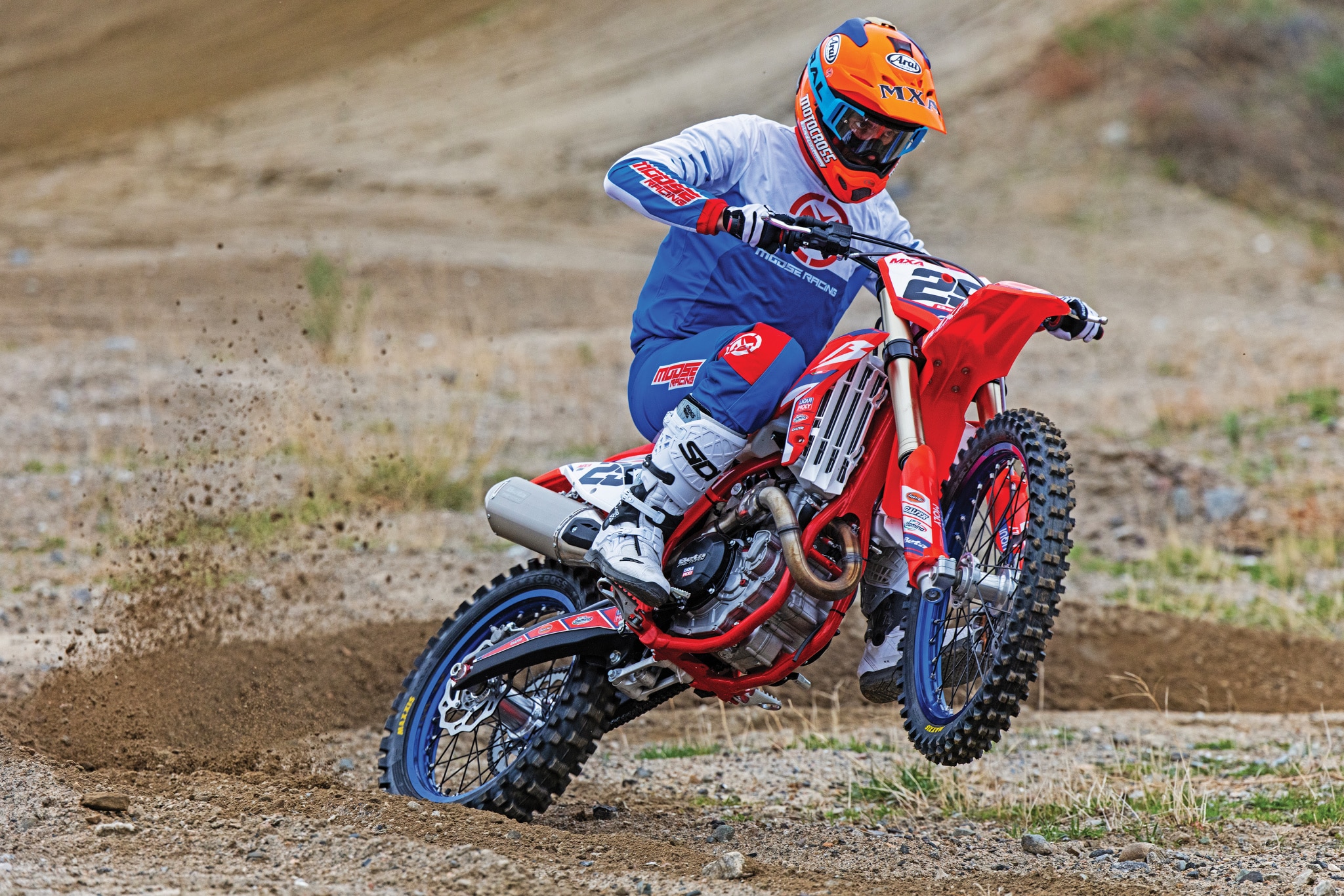 THE GEAR: Jersey: Moose Qualifier, Pants: Moose Qualifier, Helmet: Arai VX-Pro4, Goggles: Viral Brand Signature Series, Boots: Sidi Crossair X.
THE GEAR: Jersey: Moose Qualifier, Pants: Moose Qualifier, Helmet: Arai VX-Pro4, Goggles: Viral Brand Signature Series, Boots: Sidi Crossair X.
Q: FIRST AND FOREMOST, IS THE 2025 BETA 450RX BETTER THAN THE 2024 BETA 450RX?
A: Last year we said, “It reminds our more experienced test riders of the 2012 KTM 450SXF—a bike that wasn’t quite race-ready in stock form but had great potential once you got the suspension dialed in.” This year the Beta 450RX has taken a step forward, but it’s not the leap we were hoping for. 
The Beta 450RX stands out as one of the most exotic-looking bikes in the pits.
Q: WHAT’S NEW ON THE 2025 BETA 450RX?
A: We had a wish list of updates for the 2025 Beta, and, surprisingly, the Italians addressed many of the issues we had on our list. Here’s what’s new:
(1) Suspension. While it kept the same spring rates, the Kayaba suspension valving was updated front and rear.
(2) Mapping. Beta claims that the 2025 450RX has received mapping updates for the new year, but we didn’t notice a massive difference. We think it’s one step better, but it didn’t address our complaints.
 The new pegs are much better.
The new pegs are much better.
(3) Footpegs. Last year’s footpegs looked like they would work, but they were all slip and no stick. Thankfully, the 2025 footpegs are sharper and grippier.
(4) Bar mounts. The bars are 5mm taller now, thanks to the new rubber-cushioned bar mounts. Rubber is a good thing, but taller is not.
(5) Battery. The 450RX has a tendency to flame out easily, which means you’re hitting the e-starter often. We wish they would have fixed the flame-out issue, but instead they just installed a stronger battery.
(6) Gearing. Last year they had a fancy dual-layer rear sprocket (aluminum inner with steel teeth). They added a tooth on the rear with a 51-tooth sprocket, and it’s all aluminum now.
(7) Rear axle. The rear axle went from 20mm to 22mm for more stability.
(8) Bodywork. The plastics are the same, but the front fender and front number plate went from blue to red.
(9) Subframe. The rear subframe and air-filter-box geometry are the same, but Beta says they have been reinforced for stiffness and strength. Access to the air filter is still tool-less, and it still comes with a Twin Air filter.
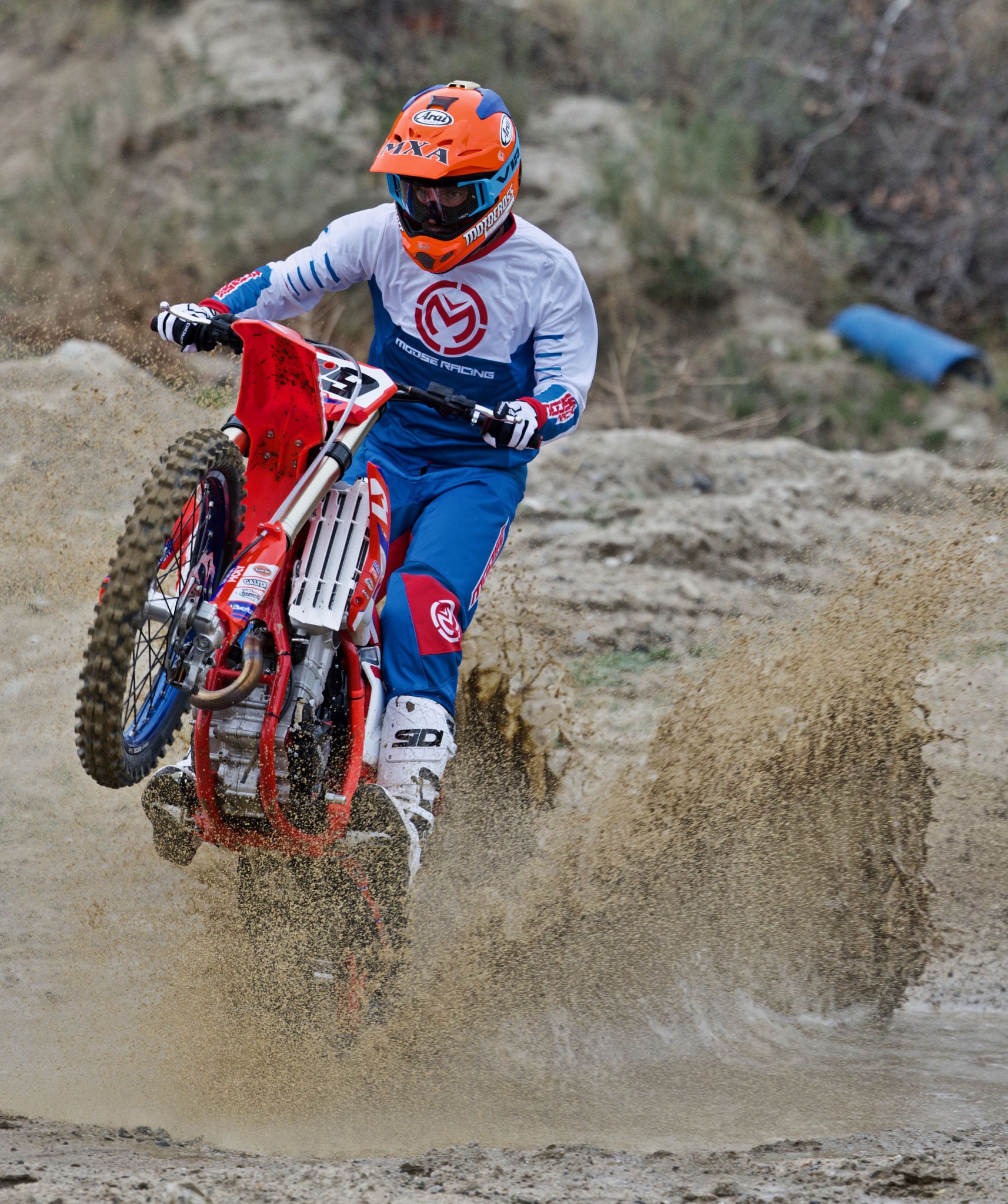 The Beta 450RX has off-road roots, so we thought it only right to take it to a couple off-road races.
The Beta 450RX has off-road roots, so we thought it only right to take it to a couple off-road races.
Q: WHAT SEPARATES BETA FROM TRIUMPH AND DUCATI?
A: Our future selves will look back on this time, remembering the anticipation of new manufacturers entering our world and every little milestone that came with it. First, the excitement we felt seeing the glamorous pictures of the bikes online, then seeing them at the races, either in person or on TV, then seeing them for the first time at the local track, and finally, experiencing these new bikes for ourselves.
Four new brands have entered our sport in a big way. Triumph and Beta came out with 2024 motocross models, and Ducati is coming out with its Desmo450 MX this summer as a 2026 model. You might not have expected us to say it, but Stark is the fourth manufacturer. Even though they’re making electric bikes and they’re not approved for Supercross yet, they’re still shaking things up in our world, and their bikes are showing up at the local tracks.
Beta is different from the other three brands, though. They’ve been producing dirt bikes for years, just not motocross bikes. Yes, Triumph was a pioneering brand at the early stages of motocross in the ’60s and early ’70s, but that’s when hardcore racers were taking street bikes and converting them into dirt bikes. When Triumph and Ducati committed to motocross, they didn’t have previous dirt bikes to build off of, so they had the blessing and the curse of starting from scratch.
Beta’s situation is a challenging one. The positive for Beta is that they already have a full lineup of unique four-stroke enduro bikes—350RR, 430RR and 480RR. While Triumph, Ducati and Stark went the expensive route to build what they wanted, Beta had a slight head start because they saved money by using the bones of their enduro bikes as a starting point and then tweaked everything from there.
Q: HOW DID BETA DEVELOP ITS 450RX MOTOCROSS BIKE?
A: Beta has long been a boutique brand specializing in off-road and trials bikes, but now, Beta is interested in motocross and Supercross. Beta’s first motocross-specific bike was the 2021 300RX two-stroke. At the time of its release, Beta began development of the 450RX, using the MXGP series as a testing ground for turning its off-road bike into a motocross bike. The MXGP World Championship is the perfect arena for race testing a prototype. How so? The MXGP doesn’t have a production rule. Beta, Triumph and Ducati could build one-off prototype frames, swingarms and engines, and take them racing (as long as they met the basic displacement and minimum weight rules).
However, when it came to racing in the USA, Beta had to wait until they were ready to import 400 units for sale before they could homologate their bikes for racing AMA Supercross and motocross.
Beta already had an interesting spread of four-stroke engines, but they were missing a 450cc powerplant. The 450RX engine, of course, looks and sounds like the Beta 480RR off-roader, but it was configured for motocross use. It has a five-speed transmission with separate oil compartments for the engine and transmission. It has a four-valve head, finger-followers, dual cams, a hydraulic cam-chain tensioner and is fuel-injected via a 46mm throttle body. It uses a hydraulic Belleville washer spring clutch with a steel clutch basket and Brembo hydraulic clutch actuation. Like other Belleville washer spring setups, the clutch has three tension settings on the spring to adjust the feel. It also comes with a stainless steel HGS exhaust system.
The 2025 450RX is suspended by Kayaba’s closed-cartridge, 48mm, AOS spring forks and a 50mm Kayaba rear shock, and relies on Nissin brakes for stopping. As for its basic bones, the 450RX frame looks the same as the off-road models, but it’s stiffer with 10mm of added material around the steering stem. The cherry red, chromoly steel 450RX frame is robot-welded, and the steering-stem angle is steeper than on their off-road bikes for sharper cornering. The engine is rotated slightly back in the frame as well. The 450RX head stays are also specifically designed for motocross. After purpose-building the frame for motocross, Beta decided to utilize this same frame for its Race Edition Beta RR off-road four-strokes for 2025.
Q: HOW DOES THE 2025 BETA 450RX ENGINE RUN ON THE TRACK?
A: Beta’s tagline “rideability” isn’t something that we’re used to in motocross. We are used to OEMs bragging about how fast their engines are, even if they are slow. Kawasaki’s KX450 engine is mellow for a 450 four-stroke, but it suits a lot of riders because it is user-friendly. “Mellow” isn’t a great marketing term for a dirt bike, so they don’t use the term “mellow” in their advertising. The Italians are proud, though; they stand behind their product, and their marketing tagline matches how the engine actually feels—rideable.
 The 450RX does its best work when you short-shift it.
The 450RX does its best work when you short-shift it.
We said it last year, and we’ll say it again: the 450RX has a tractor-like powerband. If for some bizarre reason you asked us to mount a dozer blade to the front of a motorcycle and push dirt with it, we’d use this bike. It’s tractor-like because it has a heavy feel that doesn’t like to rev quickly. For example, when you drop the clutch and blip the throttle quickly coming out of a corner, the ignition chirps ever so slightly. If you’ve ever ridden a new-generation Austrian bike in QuickShift mode, it sounds like that. QuickShift mode on a KTM/Husky/GasGas, or any high-end street bike or muscle car, cuts the ignition for the split second when you upshift to take the lash out of the gearbox, making it easier to shift without having to use the clutch; however, to motocross guys, it sounds scary. We’re not used to hearing our ignition cut off, and strangely, that’s what the Beta does when you wick on the throttle really quick. We should mention that this didn’t happen to every one of our test riders, and it didn’t happen in every corner. Only our most aggressive test riders complained about this. Eventually, every test rider got used to it.
The Beta 450RX is deceptively fast in the midrange. The dyno numbers show that the Beta peaks at 57.8 horsepower at 9900 rpm, with 34.78 pound-feet of torque at 7400 rpm; however, the rev limiter on the Beta is not friendly. It’s more like the old-style rev limiters that make the engine fall on its face once it kicks in. Our test riders are spoiled with modern four-strokes that rev freely, free-wheel into turns and never want to sign off. The Beta is great in the midrange, but as soon as you go wide open and climb up in the rpm, the chassis binds up. And, once you hit the rev limiter, the engine doesn’t just fall flat, it completely drops off. There’s no grace period after the rev limiter. You must shift early or you will be punished.
FMF works with the factory Beta team, and they sent us a Factory 4.1 titanium system for our test bike. It boosted power and made the bike look way better, but it didn’t free up the engine like we hoped it would since the rev limiter is a separate system. The Beta still delivers a heavy feel, but it is faster with the FMF pipe installed.
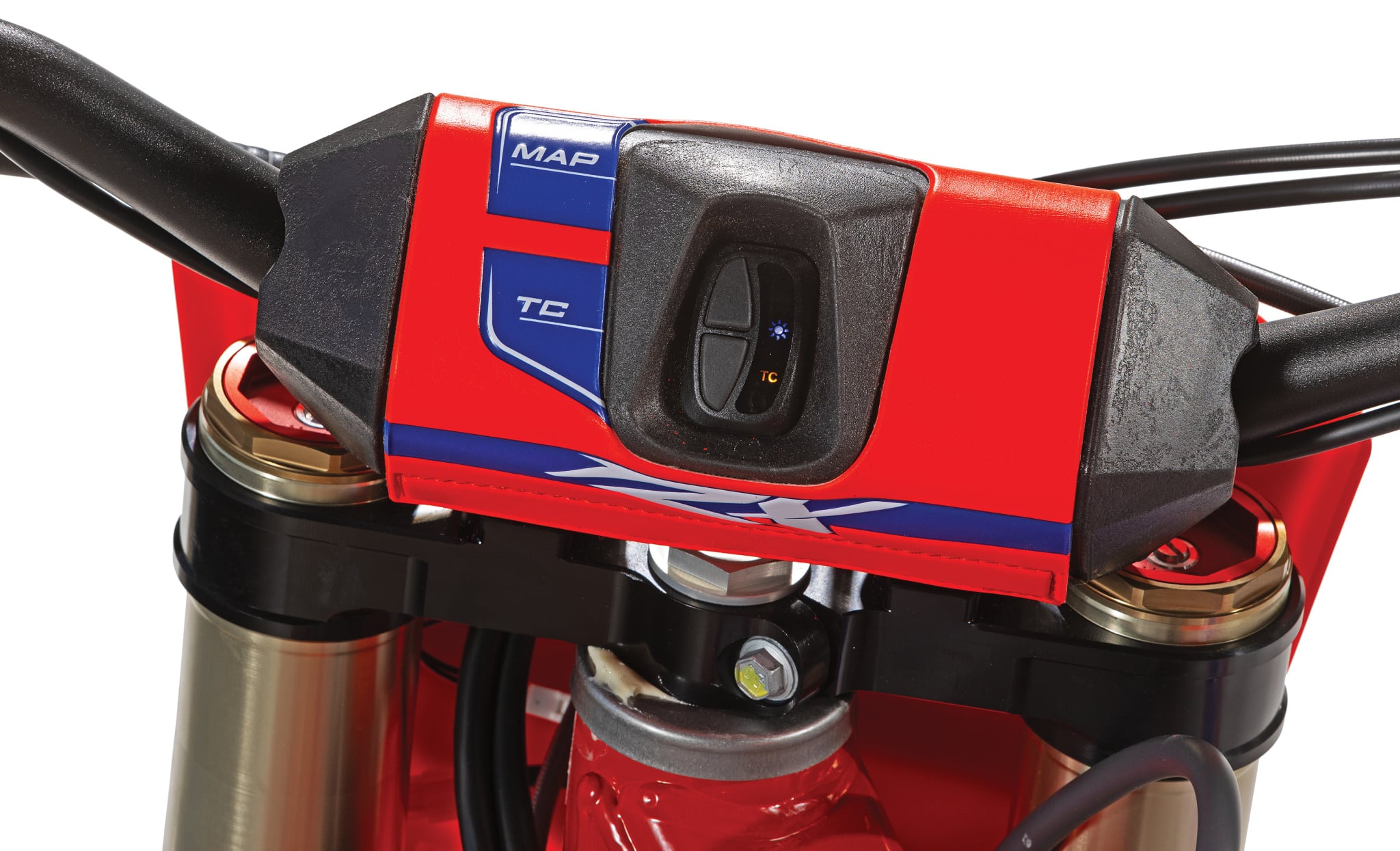 The map switch is in the bar pad.
The map switch is in the bar pad.
We should mention that the Beta comes with two map options; however, instead of numbers, they use a sun icon to indicate the stock map and a rain-cloud icon to indicate the mellow map. On the dyno, the mellow map took the Beta from 57.8 to 53.7 horsepower and from 34.8 pound-feet of torque to 32.8 pound-feet of torque—a massive difference! Some of our test riders said that the mapping ran cleaner in the mellow mode, but it was too slow to race with.
Q: WHAT IS IT LIKE TO WORK ON THE BETA 450RX?
A: The Beta 450RX is a big motorcycle, and the steel frame provides easy access for most maintenance and parts changing on the chassis. The rear shock can be removed without lifting or removing the subframe. You just remove the muffler to get access to the top and bottom shock bolts, and the shock will pull out through the right side of the subframe. Of course, the dual oil compartments make routine oil changes more of a hassle, but there are other nice features about the Beta, like the tool-less air-filter cover and push-button seat removal.
One thing we adjusted in the engine was the cam-chain tensioner. The stock tensioner is a spring-controlled-type tensioner. It has a self-tightening feature that doesn’t require maintenance and allows for safe operation. This design won’t allow for slack in the valve train, and if over-tightened, either from revving the engine excessively or from incorrect assembly, it can result in over-tensioning the cam chain, causing excess drag. Beta does sell a manual cam-chain-tensioner assembly. It requires proper assembly and regular maintenance to ensure proper valve-train timing, but eliminates the possibility of an accidental cam-chain over-tensioning situation.
We noticed some extra drag on our engine, so we decided to reset the cam-chain tension. Before you reset it, it’s best to make sure the engine is locked at top dead center on the compression stroke. Then, remove the top-dead-center locking bolt at the front of the engine (6 inches in front of the oil-drain plug). Remove the washer and then reinstall. Your engine will be locked at top dead center.
Now you can take the cam-chain tensioner out and reset it. To do this, take the end cap off, then the spring comes out, and you can remove the whole assembly. The tensioner drum will be poking out of the other side. That’s what is pushing against the cam chain guide. Take a screwdriver and push it all the way out, then reset it by putting it back into the assembly from the front with the hole pointing out for the spring. Then, push the drum back in so it’s flush to reset the tensioner. From there, reinstall the assembly back into the cylinder head. Install the spring, and then tighten the cap back down. As you tighten the cap down, it will push the tensioner up to the proper position against the guide based on how tight your timing chain is.
We did this after breaking the engine in, and it seemed like it freed up the engine slightly, but it didn’t make a world of difference in the engine’s character.
Q: HOW DOES THE 2025 BETA 450RX HANDLE ON THE TRACK?
A: Last year the talk was all about the suspension. The forks were harsh on top of the stroke, and then they blew through when they bottomed out. This year it’s flipped. They’re too soft on top, and they dive under braking. Then you’re stuck riding in the harshest spot of the fork’s stroke. We dropped the forks in the triple clamps to play with this and ended up with the fork height at 2mm. We also went big and added 10cc of oil to the forks. We found that the higher oil height helped with hold-up.
Initiating corners isn’t easy, but once you’re committed to turning, the 450RX wants to steer. Most of our test riders preferred the sag between 102mm and 105mm.
Another mod we made was adding Ride Engineering’s 20.5mm offset triple clamps. Not only did they change the geometry of the Italian stallion, going from 22mm of offset to 20.5mm, they also helped with the front-end feel. The split triple clamps were more forgiving in the bumps, too. Bringing the offset to 20.5mm makes the wheelbase slightly shorter and reduces trail, which affects straight-line stability and cornering. The front wheel feels more connected to the chassis with the Ride Engineering clamps, giving the bike a more predictable feel. The change didn’t solve all of our handling problems, but it helped. With Ride Engineering’s clamps, sag stayed the same for most testers, but for some of our vet riders, the bike steered too quickly with 105mm of sag. They preferred the sag at 110mm because it weighted the rear more and smoothed out the corners.
Of course, the Beta 450RX has off-road roots, so we thought it was only fair to have a play day on the trails with it to see how it liked the tight stuff. As we expected, the 450RX shines off-road. The only complaint we had in the technical stuff was that it would flame out and we’d stall it easily. Other than that, the Beta 450RX ate up the trails, rocks, bumps, ruts and even jumps. What did we learn from this? The chassis handles best when the engine is at its best. This engine doesn’t like to be revved, and on the trails, we were in the midrange the whole time.
Q: HOW ARE THE ERGOS ON THE 2025 BETA 450RX?
A: The Beta 450RX is tall, really tall. Our shorter riders were intimidated by the 450RX, and they struggled to saddle up on it. You can tell just by looking at the photos that the steering head is high up in the sky, which places the handlebars very high as well. The bars themselves aren’t too tall, but they’re flat with hardly any sweep. Our test riders also complained about the Domino grips. They’re fat in the middle and thinner on the inside where your pointer fingers and thumbs grab on. Our testers ended up with “Yama-thumb,” which is a phenomenon where you get a blister on the outside of your thumb joint. It typically happens on Yamahas because the throttle grip is too close to the throttle housing, causing your thumb to be rubbed raw.
Our biggest ergonomic complaint is with the fuel tank; it’s wide up front (like an older Yamaha), and it bows your legs out in the corners. Our test riders ride frequently, and they complained about sore hip flexors after riding the Beta because of the tank. The gripper seat cover is nice for keeping the rider planted on the bike, preventing him from sliding back and getting arm pump, but the foam is thin and not overly comfortable.
Yes, we have a lot of gripes about the ergos, but, surprisingly, our boots didn’t snag on any of the plastics, and we didn’t have any issues moving forward and backward on the bike.
Q: WHAT DID WE HATE?
A: The hate list:
(1) Weight. The Beta 450RX weighs 239 pounds, which is the same weight as the Suzuki RM-Z450 and Kawasaki KX450.
(2) Suspension. The suspension got better for 2025, but it’s not where it needs to be.
(3) Rev limiter. This engine is great in the middle, not on top.
(4) Maintenance. The dual-compartment transmission and engine-oil situation complicate the process of a routine oil change.
(5) Fuel tank. The translucent tank is nice for checking fuel, but it does make the Beta look like an off-roader. It also takes time to get used to how wide it is.
(6) Bar pad. We don’t like that the map switch is in the bar pad. Also, it looked like the bar-pad cover was painted red because it started peeling off on the first day.
(7) Sound. The Beta doesn’t sound good when you snap the throttle quickly or when it hits the rev limiter, and sound plays a role in user experience.
(8) Seat. The seat could use more foam, but that’s a catch-22 because the bike would be even taller.
 The toolless airbox cover and stock Twin Air filter.
The toolless airbox cover and stock Twin Air filter.
Q: WHAT DID WE LIKE?
A: The like list:
(1) Updates. The Beta still has a lot of room to improve, but we’re thankful the Italians didn’t rest on their laurels for 2025. They made steps in the right direction, addressing many of our complaints from last year.
(2) Power. This engine is deceiving. Once you understand its quirks, you can go fast on it.
(3) Aesthetics. The fluorescent red and blue plastics are bright, and the sharp design makes it uniquely Beta. It doesn’t look like another brand. The black swingarm, black brake and clutch master cylinders also make the bike look factory.
(4) Footpegs. The footpegs are better than last year’s pegs, which felt like banana peels.
(5) Brembo. We like the Brembo clutch actuation.
(6) No-tools filter. We appreciate that we can access the Twin Air filter without tools.
(7) Throttle cams. We’re glad they offer four extra throttle cams to adjust the power delivery. We preferred the black number 44 quick-turn cam.
(8) Radiator cap. Beta didn’t skimp on the small stuff. They have a 2.2 radiator cap on for durability.
 The KYB forks are much improved for 2025.
The KYB forks are much improved for 2025.
Q: WHAT DO WE REALLY THINK?
A: The 2025 Beta 450RX is one big step better than the 2024 model, but we were even more critical of it in our test this time around. Why? With more time on the Beta, we see its potential, and we’re frustrated that we aren’t more comfortable with it yet. We’re not giving up, though. The Beta 450RX engine is unique, but we love how usable and friendly it is in the midrange. The Beta 450RX is perfect for anyone who wants to stand out from the crowd.
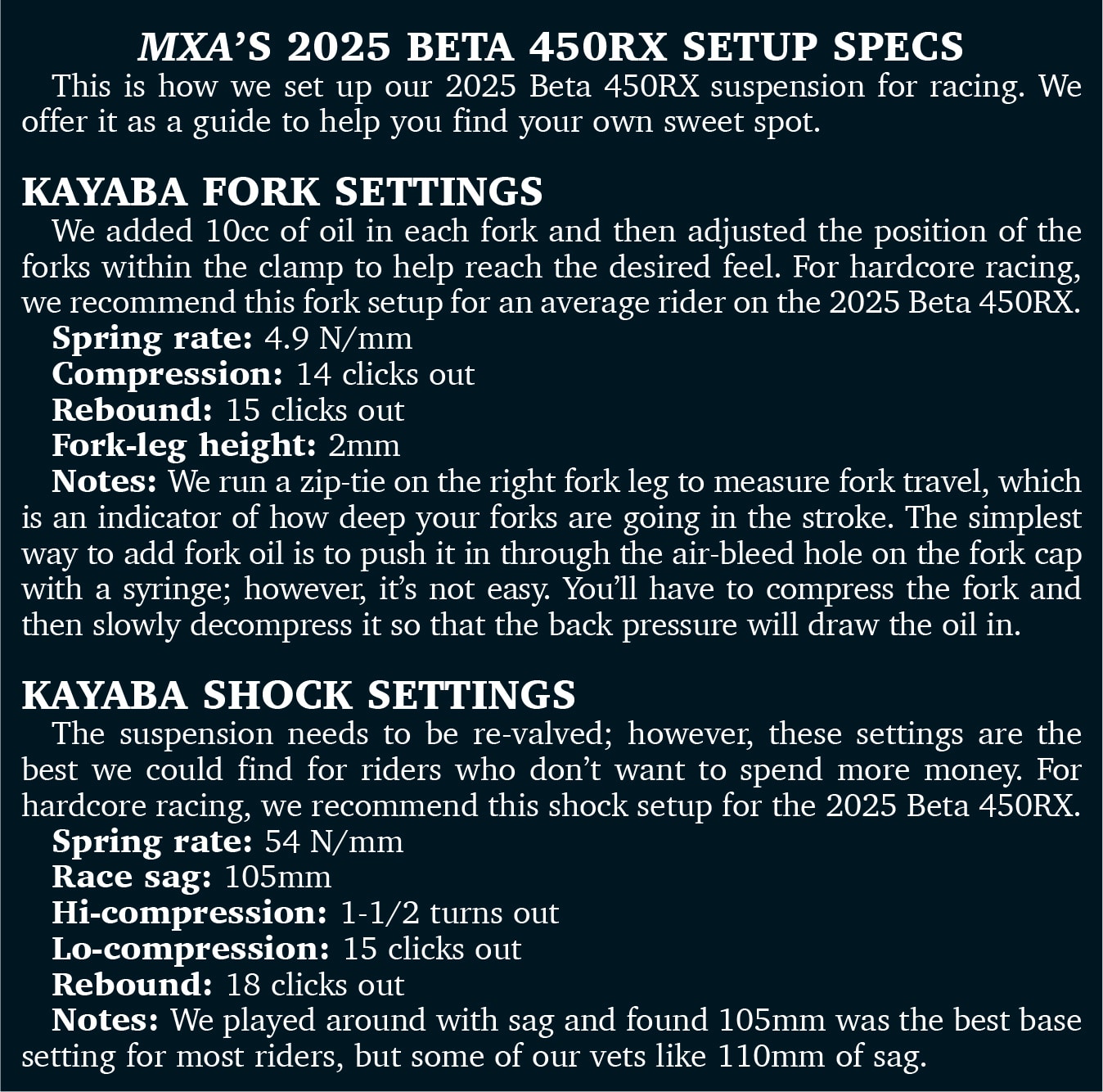


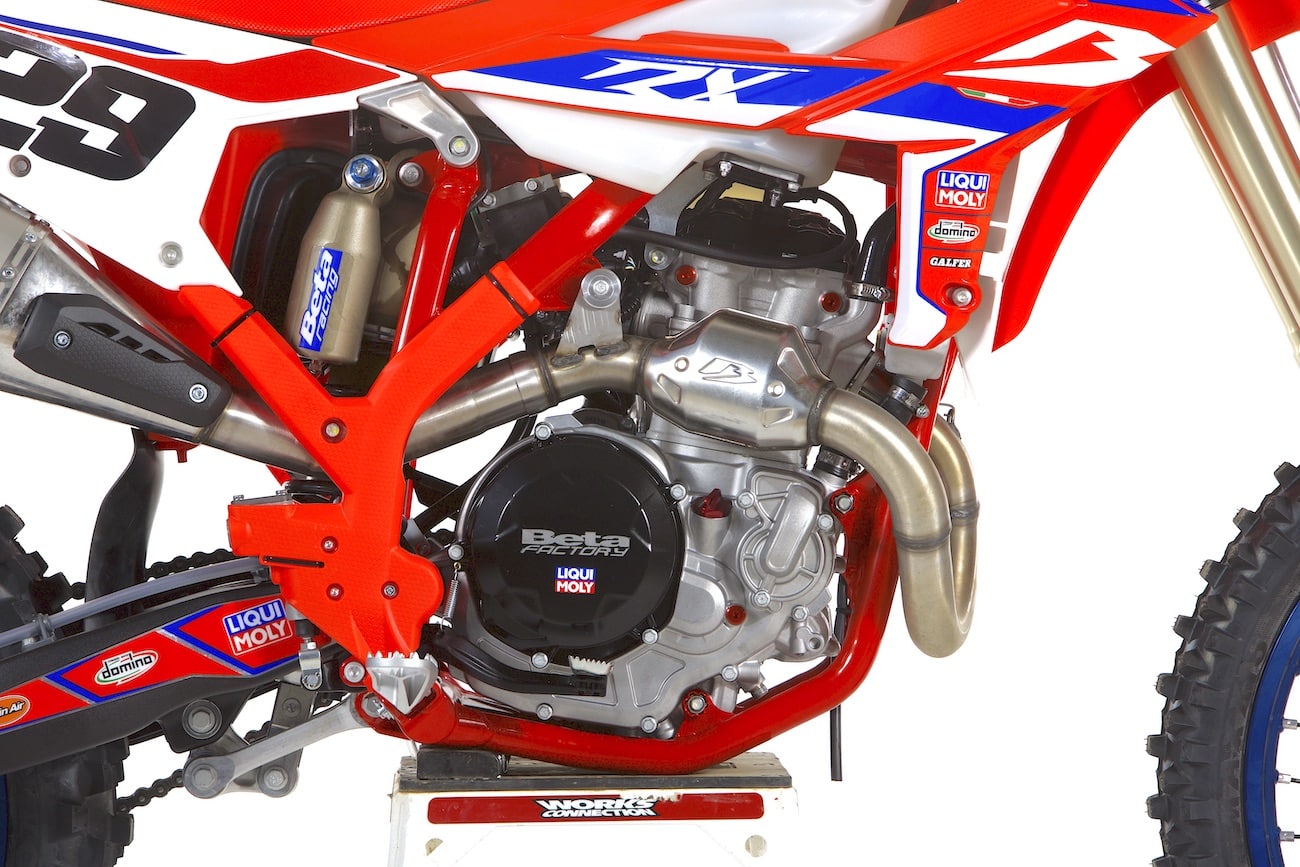

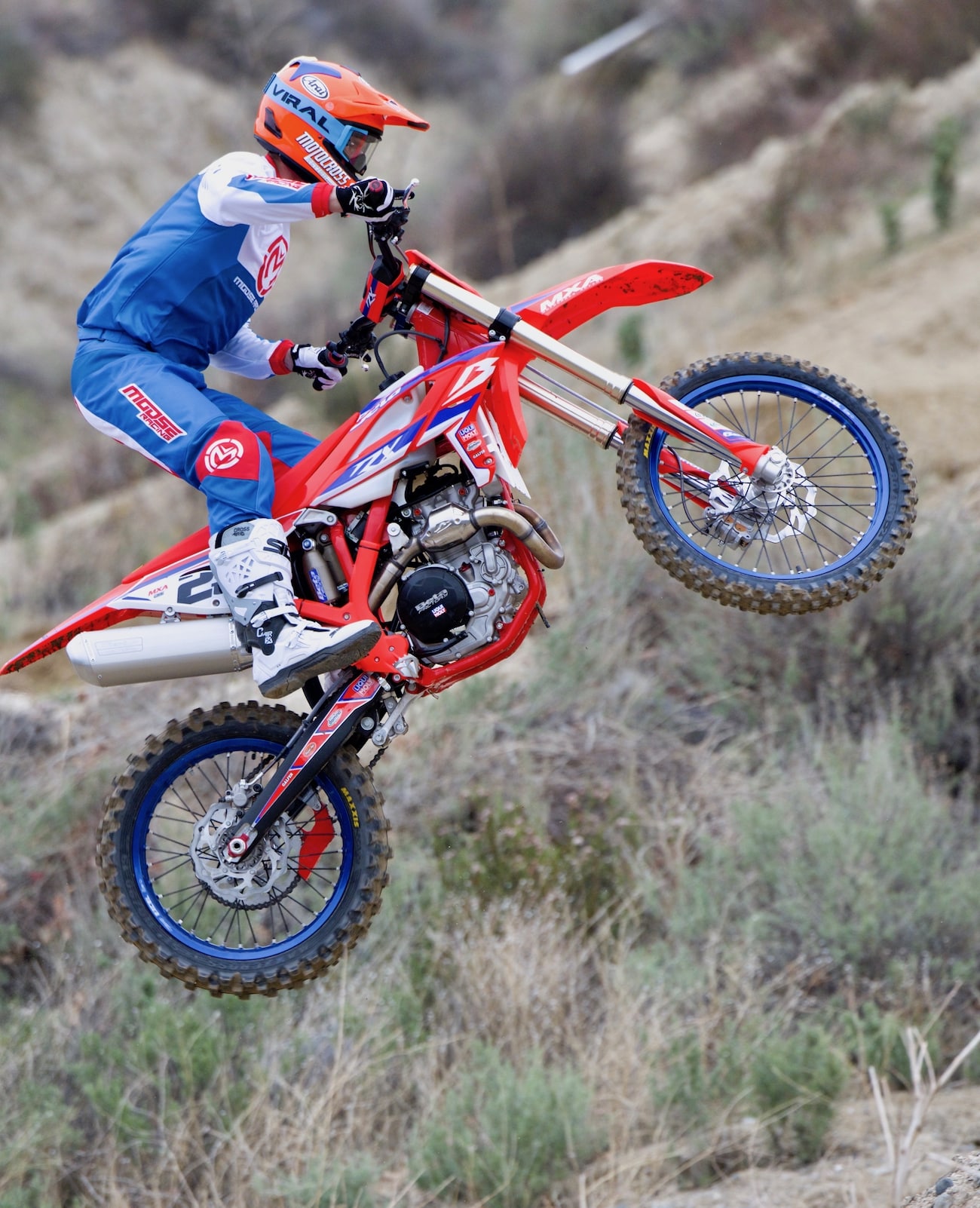
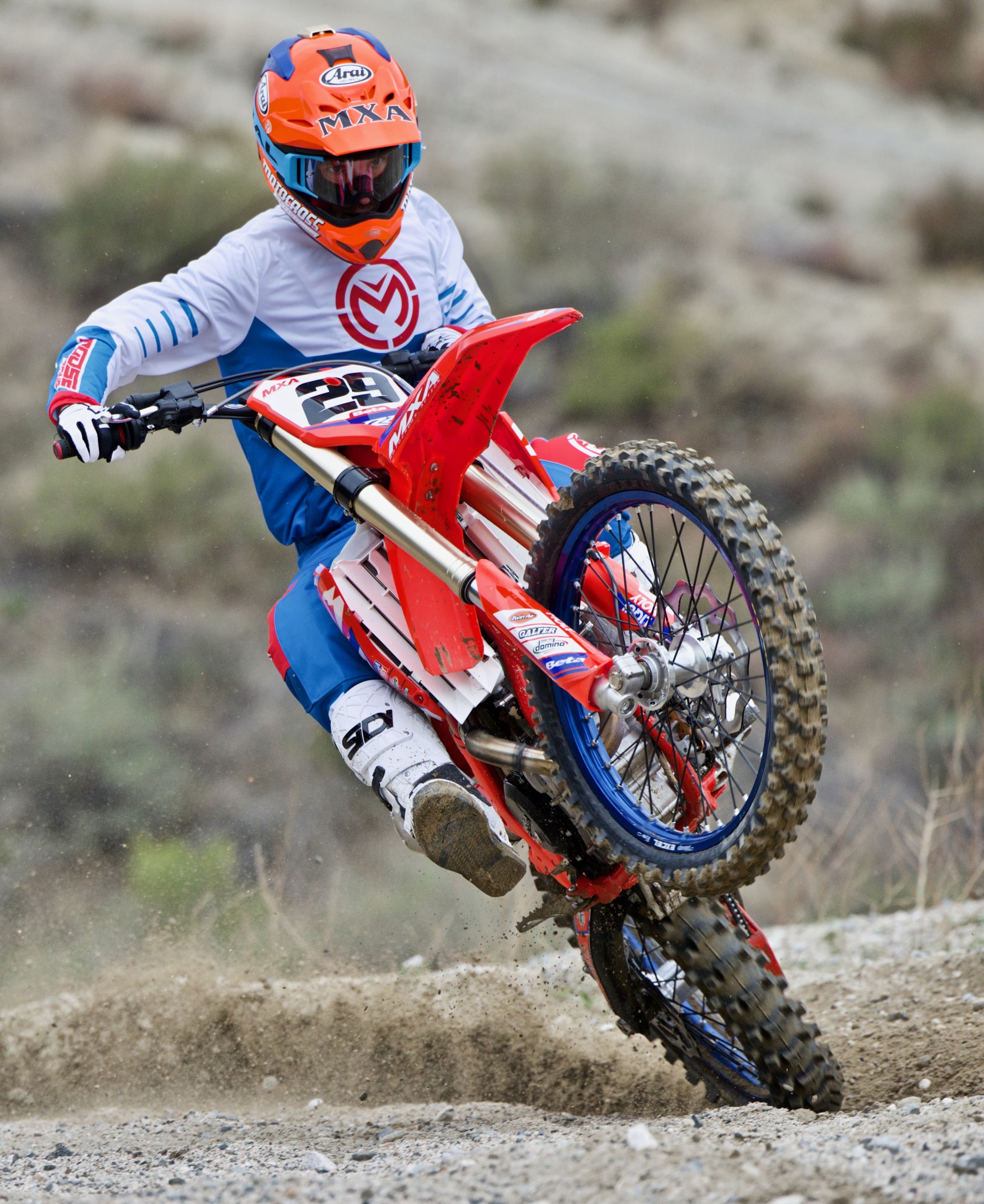


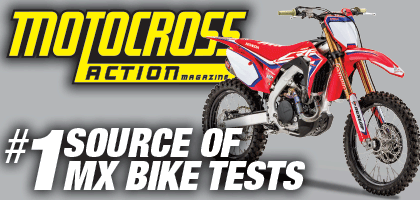


Comments are closed.